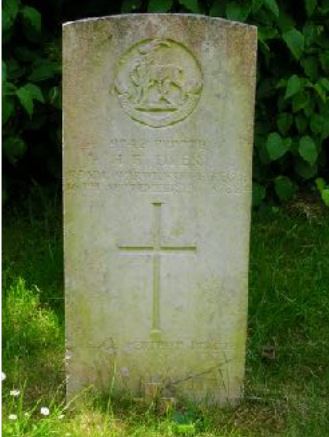10th Battalion, Royal Warwickshire Regiment

The adage, ‘never believe what is written in the newspapers’ is true, in respect of Private Harry Emmanuel Dyer, for reasons explained below.
Harry Emmanuel Dyer was born in 1891 in Sevenhampton, near Andoversford, Gloucestershire and was baptised in the parish church on 8 March 1891.He was the son of Francis (Frank) William Dyer (1854-1926), a miller and his wife Georgina (née Bowditch: 1857-1932), who originated from Dorset. The couple had married in Bridport in 1880 and (according to the 1911 census) had six children.
At the time of the 1901 census Harry was living at the family home at Lower Sevenhampton. By 1911 he had left home and was living as a boarder at nearby Brockhampton Park, where he was employed as a gardener.
Private Harry Dyer’s Army Service Record is amongst those destroyed by enemy action in 1940. As a result, it is not possible to determine the exact date he joined the Army: almost certainly it was at the start of the Great War and Soldiers Died in the Great War records that he enlisted at Rugby. His entry in the Medal Roll for the Royal Warwickshire Regiment shows that he was posted to the 10th Battalion and his Medal Index Card states that he first went to the Western Front (with the battalion) on 18 July 1915. The 10th Royal Warwicks became part of 57 Brigade, 19th Division and prior to landing in France had been based at Tidworth, Wiltshire.
The Gloucestershire Echo of 23 September 1915 carried a report of Harry’s funeral and it stated that he was ‘seriously wounded at the Dardanelles’. This was untrue, as the 10th Royal Warwicks were never sent to the Gallipoli Peninsular. The battalion’s War Diary reveals what happened to Private Dyer and where.
Having joined the British Expeditionary Force (BEF) in France in July 1915 the 10th Royal Warwicks undertook a period of training, which included short spells in the front line trenches, before undertaking full front line duties. On 28 August it left the rear area at 5.45pm and the troops undertook a four mile route march up to a section of the front line situated north of the La Bassee Canal, between Festhubert and Violaines, known as known as ‘Canadian Orchard’. By 10am on 29 August the 10th Warwicks had replaced the 2nd Gordon Highlanders and almost immediately suffered some casualties from enemy fire. The morning of the 30th of August was quiet and the Battalion’s CO escorted Brigadier-General Twyford, OC, 57 Brigade on an inspection of the front line trenches: apart from a little shelling, the rest of the day was quiet. The lull persisted through to the following day and plans were laid for the 10th Warwicks to be relieved by the 8th North Staffordshires.
On 1 September the Germans made a bombing (or grenade attack) on the front line trenches. On what the War Diary describes as a ‘fairly quiet day’, the Battalion sustained nine casualties, which included one dead. Very unusually for a war diary, the names and numbers of the casualties amongst the other ranks are listed: 9942 Private Dyer, H E (A Company) is one of those shown, as being wounded in ‘head and knee’.
Private Dyer would have been sent down the casualty evacuation line and the seriousness of his wounds must have dictated repatriation to England, where he ended up in Reading War Hospital. Here he died of his wounds on 16 September 1915, aged 24.
Harry Dyer was buried in the churchyard of St Andrew’s, Sevenhampton on 21 September 1915. His funeral was attended by various family members and one of the wreaths was ‘from a broken hearted sweetheart’. His grave is now marked by a standard CWGC headstone and he is commemorated on the war memorial plaque located inside St Andrew’s Church.

Researched by Graham Adams 4 October 2020
